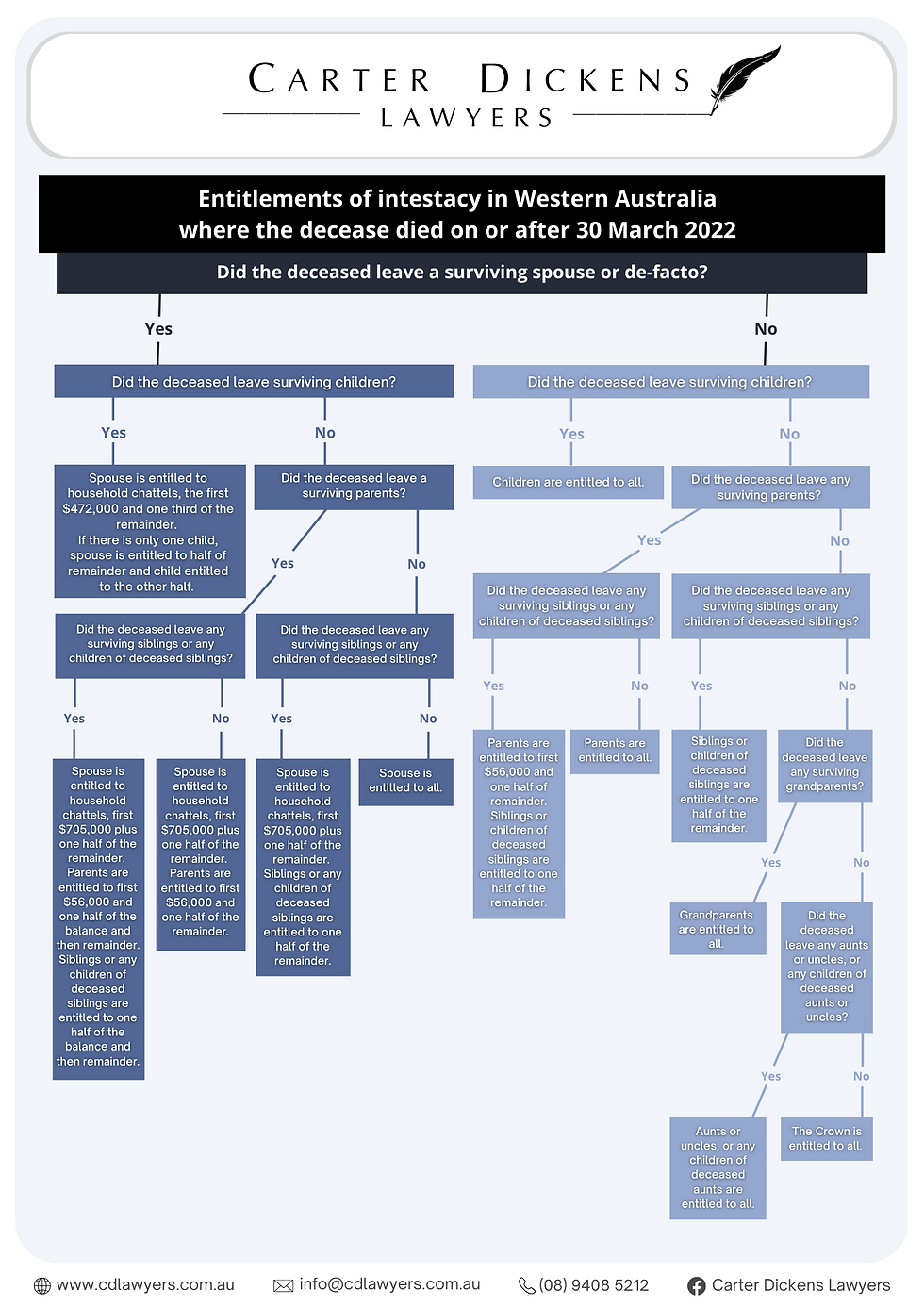Passing Away Without a Will
- Jarrod Carter
- Jan 18, 2023
- 4 min read

Having your last Will and testament prepared is an inconvenient chore. You have to go and speak to a lawyer and discuss your private finances with the added fun of confronting your own mortality. It’s also hard to care about because it's easier to just pretend you will live forever. Or maybe that is just me?
In Western Australia, if you don’t have a valid Will at the time of death, you are considered to have died “intestate”. In that event, the policy of the government, as set out in the Administration Act 1903, determines how your estate is distributed .
Before we get into that, it is helpful to know what assets are not included in your estate. Property that is owned as joint tenants is not included in your estate. This is because you both collectively own 100% of the asset. You do not own it on a 50/50 basis. You therefore cannot bequeath a share of the asset in your Will. Examples may include the family home, and joint bank accounts. If you own your house as joint tenants with your spouse, your spouse automatically owns 100% of the asset after you pass away.
Superannuation is also not part of the asset pool in many respects. A superannuation interest is legally owned by the trustee of the Super fund. This means you are only the beneficial owner of the Super until you cash it out. The trustee of the Super fund can determine how the proceeds of the fund are distributed to your loved ones. They often follow the Will if there is one, but in the absence of valid Will, the trustee decides. One way around this is to complete a “Binding Death Nomination” which affirms your strict legal instructions to the trustee to distribute your Super in accordance with your wishes. These must be updated every two years.
If your assets consist of a house and bank account owned as joint tenants with your spouse, and a Superannuation interest that has a binding nomination, then you may not actually need a Will. This is something best to confirm with qualified legal advice.
Other than joint tenant assets, and assets held in trust like superannuation, most other types of assets form the estate. When a person dies intestate, their assets will be distributed among their surviving family members according to a specific order of priority set out in the Administration Act 1903, section 14. The Act provides for a hierarchy of potential beneficiaries, beginning with the deceased's spouse or domestic partner, then children, parents, siblings, grandparents, uncles and aunts, and nieces and nephews. The following flow chart explains how it works:

By referring to the chart, here are a couple of examples of what happens in different circumstances
If you have a spouse or de facto and no children, then they receive the entirety of your estate.
If you have no spouse or de facto, but children, then your children receive the entirety of your estate divided equally among them.
Above are the simple examples, but it becomes more complex from there. For example
If you have a spouse and more than one child, then the spouse is entitled to the household chattels (personal items and furniture in the house), and the first $472,000, and one third of whatever is remaining. The children then receive, in equal shares, the two thirds of the estate after the first $472,000 goes to the spouse.
Dying intestate tends to be a greater problem with non-traditional family structures. For example, if the deceased had remarried, he or she may not be happy with so much of their estate going to their new spouse and not their children. The Entitlements of Intestacy under the act may not align with the deceased wishes.
It's important to note that the distribution of the estate through the Administration Act is a simplified version and does not take into account the personal relationships and specific circumstances, like any debts, mortgages, or outstanding payments that the deceased may have. It is also worth noting that the laws and regulations regarding intestate succession may change over time, it is always best to consult with a lawyer to confirm the current laws and regulations.
Letters of Administration
In Western Australia, letters of administration are a legal document issued by the court that grants an individual the authority to administer the estate of a person who has died without a will (intestate). The individual who is granted letters of administration is known as the administrator.
When a person dies intestate, the Administration Act 1903 provides for the distribution of their assets to their surviving family members according to a specific order of priority. However, before those assets can be distributed, they must be collected and managed. This is where the administrator comes in.
Letters of administration give the administrator the legal authority to collect and manage the assets of the deceased person's estate, including paying any debts and outstanding mortgages, and distributing the assets according to the rules set out in the Administration Act 1903.
Letters of Administration are typically issued to the next of kin, or to a person appointed by the next of kin, like a family member, or in some cases, a solicitor. It's worth noting that administering an estate can be a complex and time-consuming process, and it may be beneficial for the administrator to seek the advice of a lawyer to ensure that the process is handled correctly.




Comments